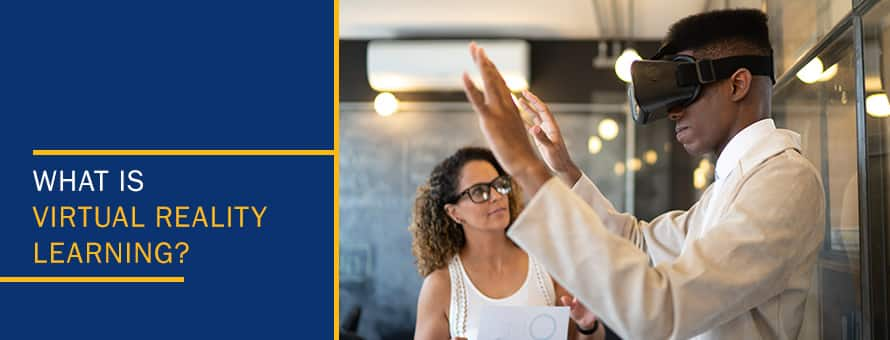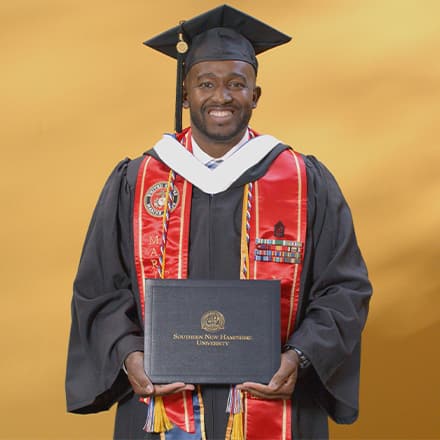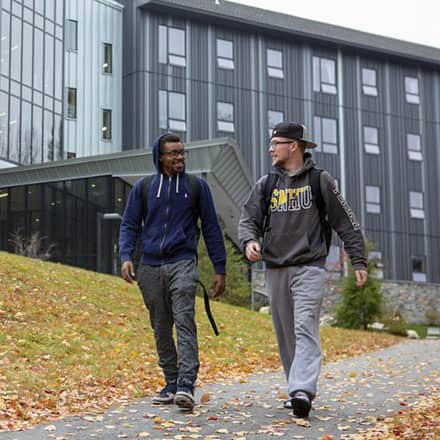Virtual Reality in Education

Virtual reality is not just for video games anymore. It has a very real place in higher education today.
By applying virtual reality technology to a wide range of training and educational purposes, institutions of higher learning are able to continuously improve, excite and innovate with new discoveries and modes of engaging learners.
What is Virtual Reality Learning?
Virtual reality is a form of technology, including special headsets and software, that together place the user inside of a simulated experience. Such simulated experiences can mirror those found in the real world, or they can be more fantastic.
SNHU Labs, the research and development unit at Southern New Hampshire University (SNHU), believes these simulated environments can be used to generate objects, sounds and other sensations that give users the impression they are in a different location, whether projecting a day-to-day or extraordinary experience.
There are different types of virtual environments. Immersive virtual reality allows users to experience only the digital environment.
By contrast, augmented reality incorporates aspects of the users’ actual environment with the virtual environment.
Mixed reality is where aspects of the real world are blended with aspects of a virtual, or artificial world. “Virtual learning leverages these approaches to creating digital immersive and blended environments,” said Seth Corrigan, senior director of assessment and game-based learning at SNHU Labs.
Advantages of Virtual Reality for Teaching and Learning
Virtual reality allows users to interact with all manner of objects and systems, including those that are too small, too large, or perhaps too dangerous to experience in real life. With virtual reality, users can assemble, disassemble, manipulate and modify objects and environments in ways that have not been possible previously.
In fact, “as learners interact with people and objects in the digital space, they are able to gain a first-hand understanding of what (those people and objects) are like and how they behave in reality,” Corrigan said. For example, social experiences or training classes can be developed through a virtual reality classroom. By providing a platform for multiple people to interact and collaborate in realistic or fantastic virtual environments, the learning process can be enhanced.
All of this together “makes it possible for learners to achieve impossible feats such as a journey inside a brain cell, travel back in time, and see the world through someone else’s eyes,” said Cat Flynn, deputy director of learning science at SNHU Labs.
How is Virtual Reality Used in Business?

The possibilities to apply virtual reality are only as limited as the imagination. Businesses of all types are using virtual environments for training and personnel development, as well as for product development and design.
For example, “virtual reality is now being used to train employees as a way to augment or replace expensive or unrealistic on-site training,” Corrigan said. “When equipment is either too far away or too expensive to have new employees working with it directly, virtual environments are being used as substitutes.”
There are huge benefits to using virtual reality in the design and engineering fields in particular because learners are able to put on their headsets and tour bridges, take apart engines and envision buildings they are designing in three dimensions, all without ever leaving the classroom.
Because virtual reality allows people to practice new processes in low-stakes environments, it can be a great training tool for professions like medicine, where surgeons can practice complex operations using three-dimensional replicas of their patients. “And designers are making use of virtual reality in fashion, store and product design to understand how customers receive and interact with their products,” said Corrigan.
Managers across all fields can use virtual reality to practice difficult conversations with employees. Lawyers can practice closing arguments. Counselors in training can practice counseling sessions.
And college professors can help students learn concepts in new ways. SNHU faculty member Dr. Peter Frost worked with SNHU Labs and the UNIT9 production company to design virtual reality experiences that require his biopsychology students to create working neurons. This unique training and learning experience places students in a human brain to build and troubleshoot a working neuron.
“As they assemble the neuron, students can scale it up make it as tall as a house or scale it down, small enough to fit in their hand," Flynn said. "The immersive lessons shift instruction from passive modalities like lectures and texts to active and realistic experiences."
What's Next in the Virtual Reality Classroom?
SNHU Labs is currently able to track details of learner activity within all types of virtual reality. The expectation is to leverage that data to develop further insights into not only how to improve specific learning experiences, but to improve teaching and learning at the course level, at the student level, and to continuously improve the learning process at the curriculum level by assessing students in an entirely new way.
"Virtual reality is on track to revolutionize how we measure and assess learning," Corrigan said.
Marie Morganelli, Ph.D. is a freelance content writer and editor at Precise Words Creative. Connect with her on LinkedIn.
Explore more content like this article

Types of IT Jobs

What is Hour of Code? A Chance to Kickstart Your Coding Literacy

SNHU Spotlight: Adaecus Brooks, BA in Graphic Design and Media Arts Grad
About Southern New Hampshire University

SNHU is a nonprofit, accredited university with a mission to make high-quality education more accessible and affordable for everyone.
Founded in 1932, and online since 1995, we’ve helped countless students reach their goals with flexible, career-focused programs. Our 300-acre campus in Manchester, NH is home to over 3,000 students, and we serve over 135,000 students online. Visit our about SNHU page to learn more about our mission, accreditations, leadership team, national recognitions and awards.

